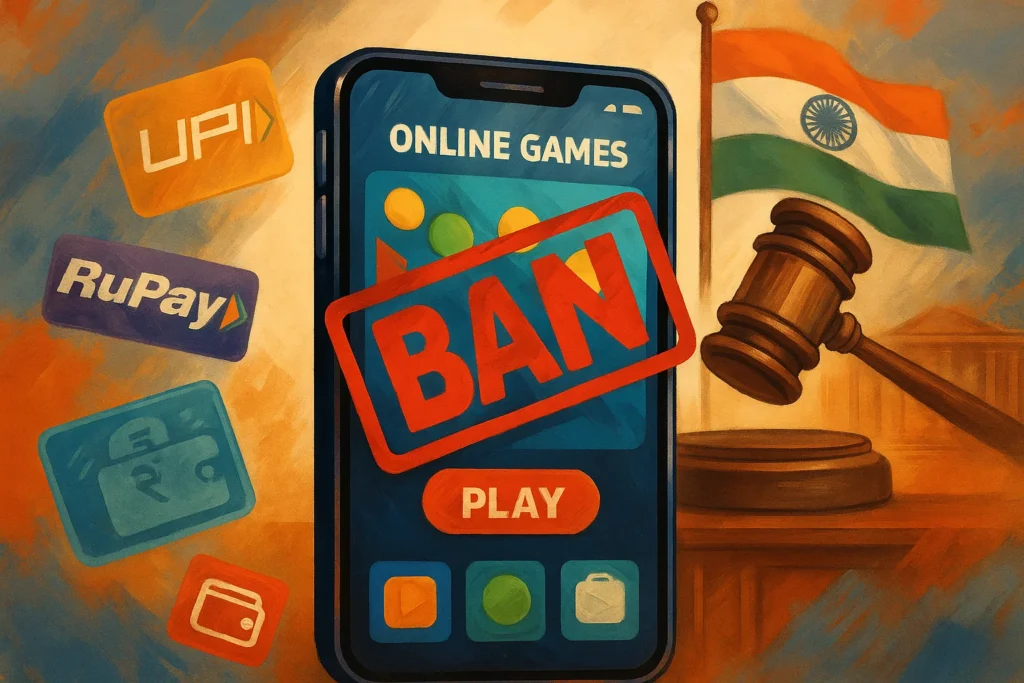Introduction
India’s booming digital economy has just hit a major roadblock. The government’s blanket ban on real money gaming (RMG) has sent shockwaves across the fintech and gaming ecosystem. At first glance, this might look like just another crackdown on online gaming platforms. But when you dig deeper, the consequences are far-reaching—touching everything from Unified Payments Interface (UPI) transactions to payment gateways, foreign investments, tax revenues, and lakhs of jobs.
The real money gaming ban India is not just about players losing access to apps like Dream11 or RummyCircle. It’s about the potential loss of ₹31,000 crore in annual revenue, ₹20,000 crore in tax contributions, 2 lakh jobs, and the trust of investors who had poured in ₹25,000 crore in FDI into one of the country’s fastest-growing industries.
Let’s break down the numbers and understand how this ban could reshape India’s digital landscape.
The Size of India’s Online Gaming Industry
Before we assess the damage, it’s important to understand how big the industry really is.
| Parameter | Value |
|---|---|
| Industry Valuation | $25 billion |
| Annual Revenue | ₹31,000 crore |
| Tax Contribution | ₹20,000 crore |
| Jobs Supported | 2 lakh+ across 400 firms |
| FDI Attracted | ₹25,000 crore |
| Active Users | 15.5 crore |
In just a few years, online real money gaming became one of India’s most promising digital industries. With over 15 crore users, it wasn’t just fueling entertainment—it was creating jobs, contributing significantly to tax revenues, and driving fintech adoption.
And then came the ban.
UPI Transaction Losses Due to Real Money Gaming Ban India
When the ban was announced, one of the first red flags was its impact on UPI transactions. UPI has become the backbone of India’s digital economy, processing billions of transactions every month. Real money gaming was a surprisingly big contributor here.
In July 2025, as per NPCI data:
- Transactions under the category ‘Digital Goods: Games’ were worth ₹10,077 crore.
- That made up 1.38% of UPI’s total transaction value.
- In terms of volumes, 35.1 crore gaming-related transactions took place—2.8% of all UPI transactions.
Now, with the ban in place, industry insiders estimate that UPI could lose:
- 25 crore transactions every month, worth around ₹5,040 crore.
- Roughly 2% hit in UPI’s monthly volumes.
- Around 0.5% drop in UPI’s total transaction value.
For a system that has become India’s pride in digital payments, this isn’t catastrophic, but it’s definitely not negligible either.
Payment Gateways Brace for Losses
If UPI is feeling the pinch, payment gateway companies are staring at even bigger losses.
Firms like Razorpay, PayU, and Cashfree had exposure to real money gaming transactions. Although these companies are diversified into multiple sectors, the sudden wipeout of a high-volume category means:
- Up to 15% hit in annual topline growth for payment gateways.
- A cumulative ₹30,000 crore decline in transaction volumes across the ecosystem over the year.
- Pressure on liquidity as mass withdrawals by gaming companies are expected in the coming weeks.
What’s even more concerning is the possibility of payout freezes and delays. To comply with the ban and avoid regulatory scrutiny, gateways might hold back or slow down payments to gaming companies. This could create system overloads and damage trust between platforms and their users.
Wider Economic Impact of Real Money Gaming Ban India
The real money gaming ban India is not just a story about fintech or gaming apps. The ripple effects spread much wider across the economy.
- Tax Revenues: The government risks losing ₹20,000 crore annually in direct and indirect taxes.
- Employment: Over 2 lakh jobs in gaming startups, tech infrastructure firms, and digital advertising are under threat.
- Startups & SMEs: Smaller firms that focused entirely on gaming will face an existential crisis.
- Foreign Investors: Nearly ₹25,000 crore worth of FDI that had flowed into the industry may now dry up, dampening global confidence in India’s policy stability.
This is not just a gaming story anymore—it’s about whether India can balance consumer protection with economic growth.
Legal Battle on the Horizon
The ban has also triggered legal challenges. Industry giants like Dream11 and Gameskraft are preparing to drag the government to court. Reports suggest that writ petitions could be filed in the Karnataka High Court as early as next week.
The legal fight will likely focus on whether an outright ban is constitutional, especially when many games fall into the “skill-based” category. Globally, countries like the UK, US, and Singapore allow real money gaming but with strict regulations. India, instead, has chosen prohibition.
Analysts from JM Financial argue that while the policy direction is clear, enforcement and compliance remain uncertain. ICICI Securities has gone one step further, warning that the ban makes RMG “essentially infeasible” in India.
The courts may well decide the industry’s future.
Investor & Market Perspective
The immediate reaction from investors is clear: caution. With one stroke of the pen, a $25 billion industry has been pushed into survival mode.
- Losers: Payment gateways, fintech firms, digital advertisers, and gaming startups that relied heavily on RMG.
- Potential Survivors: Non-RMG gaming apps, casual games, esports platforms, and entertainment apps that can pivot quickly.
- Shifts in Capital: Investors may redirect funds into skill-based gaming, fantasy-light models, and international expansion.
There’s also the question of how global investors view India after this. For many, policy unpredictability is a bigger risk than market competition.
Future of Digital Payments Post Real Money Gaming Ban India
At this point, one question dominates: Does India need regulation or prohibition?
The real money gaming ban India has undoubtedly been motivated by concerns over gambling addiction, financial losses for players, and consumer protection. But outright prohibition could kill innovation, jobs, and revenue streams.
A regulated model—with strict age checks, spending limits, and transparent taxation—could have allowed the industry to continue responsibly while protecting consumers. That’s the model followed in mature economies.
India now stands at a crossroads. The next steps taken by policymakers, courts, and industry stakeholders will decide whether this $25 billion sector thrives under regulation or collapses under prohibition.
Conclusion
The real money gaming ban India is not just about apps shutting down. It’s about:
- ₹31,000 crore annual revenue vanishing.
- ₹20,000 crore in taxes disappearing.
- 2 lakh jobs being put at risk.
- UPI and payment gateways losing thousands of crores in transactions.
This ban represents a critical test of India’s ability to balance consumer protection with economic growth. While policymakers have chosen prohibition, the industry is fighting back through legal challenges.
In the coming months, one of two things will happen: either the ban will stand, reshaping India’s digital ecosystem, or the courts and regulators will push for a more balanced framework that keeps both innovation and consumer safety in mind.
Either way, the real money gaming industry in India will never be the same again.
FAQs on Real Money Gaming Ban India
1. What is the Real Money Gaming Ban India 2025?
It is a government act that restricts real-money gaming platforms, halting cash-based online games.
2. Why did the government impose the ban?
The ban was introduced to curb financial risks, gambling addiction, and tax leakages from the gaming industry.
3. How big is India’s real-money gaming industry?
The sector is valued at nearly $25 billion, generating over ₹31,000 crore annually.
4. How does the ban affect UPI transactions?
The ban impacts about 2% of UPI’s monthly volumes, or nearly ₹5,000 crore in value every month.
5. Which payment gateways are most affected?
Companies like Razorpay, PayU, and Cashfree face revenue hits due to their exposure to gaming clients.
6. How many users are impacted by the ban?
Nearly 15.5 crore users of real-money gaming apps are directly affected.
7. Will the ban lead to job losses?
Yes, the sector supports around 2 lakh jobs, many of which face risk after the ban.
8. Can gaming companies challenge the ban legally?
Yes, firms like Dream11 and Gameskraft are planning court petitions against the government.
9. How much tax revenue does the industry generate?
The industry contributes around ₹20,000 crore annually in taxes.
10. What is the future of digital payments after the ban?
Digital payment growth will continue, but the loss of gaming volumes (~₹30,000 crore annually) will slow momentum.
Related Articles
India’s $40 Billion Spending Wave: What’s Powering the Next Consumption Boom?
Battery Energy Storage in India: The $32 Billion Opportunity Powering the Green Shift
Power Sector Boom in India: Stocks to Watch and Why It’s Just Beginning
Vehicle-to-Grid (V2G) Technology: How India Is Gearing Up and 5 Stocks to Watch





